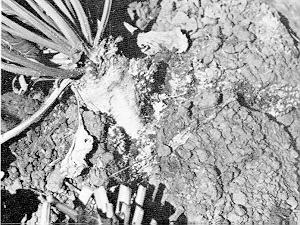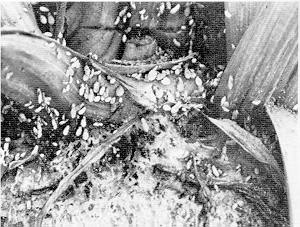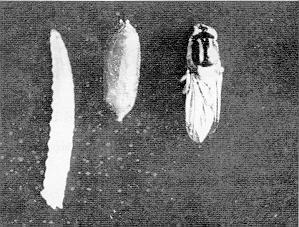| | Damage | Life history and description | Control
The sugar beet root aphid Pemphigus betae Doane, attacks sugar beets in Western Canada and sucks the juice from the roots. The insect also infests table beets, swiss chard, and such weeds as lamb's-quarters.
Damage
The sugar beet root aphid sucks the sap from the roots of beets and can destroy most of the rootlets and severely damage the tap root. A few aphids will not appreciably change the appearance of the beets but large populations will cause the plant to wilt and, if enough sap is removed, the beets will die. As populations increase rapidly and are subterranean, fairly severe damage may be done before the aphids are noticed.
When an area is subjected to an early frost, damage is generally more severe on beets that are heavily infested with root aphids than on non-infested beets.
Life History and Description
The life cycle of the sugar beet root aphid is complex. At the time that leaves of the poplar open in spring, a wingless female known as the stem mother hatches from each of the overwintering eggs.
The aphid feeds on an emerging leaf causing it to bulge downward at the point of feeding until it forms a pocket or gall containing the aphid. In the gall the stem mother gives birth to 75 to 150 female young that are winged and have a black head and thorax and a green abdomen. Between late June and early August these winged forms fly or are blown in all directions. Many land on sugar beets where they produce pale yellowish-white, wingless aphids that damage the beet root.
These summer forms of the aphid are about 2 to 3 mm long and appear to be dusted with a white powder. The rear portion of the body produces a mass of white waxy material. The aphids are most readily seen in the white mold-like material that is found on the infested beet roots and in the surrounding soil. There are several generations on the summer host each year.
 |  |  |
| Figure 1. Mold-like substance around sugarbeet root produced by sugar beet root aphids. |  | Figure 2. Sugarbeet root aphids killed by fungus disease |

Figure 3. Life stages of the predator of the sugarbeet root aphid.
In late summer and early fall the wingless aphids on the beets produce large numbers of winged aphids which fly back to poplars. These fall migrants are similar in form and color to the spring migrants. In protected places on the bark they give birth to several small, yellow, wingless aphids that are either males or females.
After mating, the female deposits a single white egg in a crevice in the bark of a poplar tree or under the bark of a dead branch, where it remains for the winter. It is only in fall that males are produced. Throughout the rest of the life cycle there are only females. These give birth to other live female young without mating so populations can increase very rapidly.
Summer forms do not all produce winged migrants in fall; a small number continue to produce wingless forms. These overwinter in the soil in beet fields or on weeds in ditches and headlands and can become established on beets in spring.
Control
The best method of reducing damage by the sugar beet root aphid is to plant the sugar beets early, irrigate them early and frequently, and keep soil fertility at a high level to permit rapid, vigorous growth throughout the season.
In Alberta the aphid may be destroyed in galls by an anthocorid bug Anthocoris antevolens White, larvae of the hover fly Syrphus bigelowi Curran, a grey fly Leucopis pemphigae Malloch, and a ladybird beetle in the genus Scymnus.
In the soil the aphids on the beet roots are mainly controlled by the larvae of a small, black and yellow chio- ropid fly Thaumatomyia glabra Meigen. This predator has been found in every field of sugar beets in the province that has been infested with root aphids. In some fields heavily infested with root aphids there were an average of 150 larvae or pupae of the predator around each beet.
In some years a fungus disease Entomophthora aphidis Hoffman completely destroys all aphids in some fields, but in other years the incidence of the disease is negligible.

Figure 4. Gall on poplar leaf caused by the sugarbeet root aphid.
Chemical controls have not been satisfactory as the chemicals that destroy the aphids also destroy the predators. Aphid populations are usually about the same in chemically-treated plots late in the season as in untreated plots, but the untreated plots often have 4 to 5 times as many predators.
Information prepared by: A.M. Harper and G. H. Whitfield
Agriculture Canada Research Station Lethbridge |
|